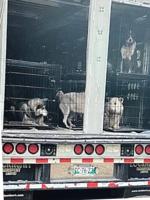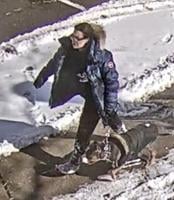On a rainy morning in September 2021, a small fleet of government vehicles rolled into a rural plot north of Barrie. As the provincial animal welfare inspectors dispersed on the property, one of them spoke to the owner, who ran a controversial sled dog business.
âWeâre here to remove your dogs,â the inspector said.
The mushing company had previously been ordered to improve the living conditions for its sled dogs that lived outside. But it failed to do so, the inspector said, and now the province was there to remove more than 100 animals from distress.
On another property some 40 kilometres away, inspectors were seizing another 100 dogs owned by the same company.
The mass seizure was applauded by animal rights groups, and seen as a notch in the belt for Ontarioâs newly minted animal welfare services. The arm of the provincial government had come into force 20 months earlier with the promise of creating a strong, transparent system to protect animals.
But the dogs started dying on the governmentâs watch.
As of March 2024, at least 31 of the sled dogs have died or been euthanized, and dozens more have become ill, according to records obtained by the Star.
The government would not say whether or how many more have died since then.
All the dogs were generally healthy at the time they were seized, according to records from Ontarioâs animal welfare tribunal.
The Star has reviewed medical records, necropsy reports, and legal records, which document troubling details about the provinceâs care of the sled dogs. The dogs were improperly shipped in a livestock transport, where they were stacked on top of each other and deprived of a bathroom break for seven hours. They were then sent out to kennels across the province, where many of them were exposed to contagious disease outbreaks.
An adjudicator found the province failed to meet the basic standards of care for animals.
The dogsâ experience, critics say, reveals fundamental flaws in the provincial system that endangers the welfare of the animals itâs supposed to protect.
âThose dogs were failed,â said Kendra Coulter, an animal protection expert who sat on the advisory table for the provincial animal welfare services from 2020 to 2022.
Redemption Pawsâ CEO denies allegations the rescue brings in more dogs than it can responsibly handle, saying, âWe are pioneers in what we do.â
Redemption Pawsâ CEO denies allegations the rescue brings in more dogs than it can responsibly handle, saying, âWe are pioneers in what we do.â
âThis reaffirms the need for government investment and proper support of infrastructure, including transportation and animal care.â
Ontarioâs animal protection services is led by the provinceâs chief animal welfare inspector, and operates under the Ministry of the Solicitor General. Neither the chief inspector nor the solicitor general responded to questions from the Star for this article.
In March 2023, Solicitor General Michael Kerzner told the legislature that the government takes âanimal welfare and safety very seriously.â
âWe are committed to developing a strong system to protect animals, and we have delivered on that promise.â
Ontario took over animal welfare reins
For 100 years, the responsibility for enforcing animal cruelty laws in Ontario was left to a charity. The Ontario Society for the Prevention of Cruelty to Animals (OSPCA) relied heavily on donations to fund its work. In 2019, facing financial strains, the charity withdrew from policing animal cruelty.
The Ontario government moved to fill in the void and established the animal welfare services, or AWS, in January 2020. It was the first provincial government-based animal welfare enforcement system in Canada.
The new Provincial Animal Welfare Services Act (PAWS Act) boasted the countryâs strongest penalties, and vowed to be more transparent and accountable than its predecessor.
But animal rights advocates say the government has not provided enough resources to live up to those promises. Instead, itâs been mostly a âsong and dance,â said Donna Power, co-founder of Humane Initiative, an animal welfare advocacy group.
âIf you’re gonna do the job, then make the investment to do it right, but they’re not willing to. But they do everything they can to appear that they are doing it,â Power said.

For 100 years, the responsibility for enforcing animal cruelty laws in Ontario was left to the Ontario Society for the Prevention of Cruelty to Animals, a charity.
Tony Bock pc28čÙÍűStarFor the fiscal year 2024-25, the Ministry of Solicitor General posted an estimated operating budget of $27 million for animal welfare services. More than $20 million was budgeted for staff salaries and benefits, about $4 million for services and $2.1 million for supplies and equipment.
âThey’ve got a budget now five times what the OSPCA had,â Power said. âAlmost 71 per cent of the entire budget is allocated towards salaries and wages. Unbelievable. That to me says everything about the priority of protecting animals in this province.â
Power said itâs concerning that the government keeps the public in the dark about how the animal welfare system works, including where the seized animals go, and whether thereâs plans to build public facilities.
The death of dozens of seized sled dogs, Power said, is emblematic of whatâs wrong with the current system.
Province’s treatment of dogs fell below standard of care
Windrift Adventures first made national headlines in 2018 when a video was posted on social media showing mostly Alaskan Huskies, a type of sled dog often bred for speed and endurance, tied to short chains and living in outdoor dog houses. One of the dogs had an open sore on its leg.
In 2021, Ontarioâs animal welfare services inspected the properties in Oro-Medonte and Severn, and issued several compliance orders. On Sept. 23, 2021, inspectors seized 239 dogs whom they determined to be âin distressâ after Windrift allegedly did not comply with the orders regarding the tether length and the uninsulated dog houses.
Windrift disputed the allegations that its working dogs were in distress. The business appealed the dogsâ seizure to the Animal Care Review Board, a tribunal that hears disputes on animal welfare in Ontario.
An adjudicator for the board upheld the AWSâs decisions to remove and keep most of the dogs, ruling that the use of tethers less than three metres long and uninsulated houses with wet bedding did not meet the standards of care.
But the board adjudicator also raised concerns with how inspectors handled and then boarded the seized dogs.
The adjudicator found that more than 100 Windrift dogs were put into black-wire crates and loaded on top of each other into a truck and trailer used for transporting livestock. The dogs spent seven hours in what appeared to be unsecured crates, without access to water and a washroom break. A dog was found to have been urine soaked and another had diarrhea.

Some of the dogs seized from Windrift Adventures.
Windrift AdventuresDuring the hearing, a regional supervisor with the governmentâs animal welfare services had testified that, when taking the entire situation into account, she had no concerns about the care provided to the animals.
But the dogsâ treatment, the adjudicator said, âfell far below the prescribed standards of care for animals in Ontario.â
The Humane Initiativeâs Power called the treatment by AWS âdisgusting.â
âYou think about a livestock trailer, those animals are completely loose and untethered. So they’re driving down the highway, they’re on bumpy country roads, they’re turning corners. You don’t think those dogs are going flying?â Power said.
The dispute has expanded beyond the review board into court, where the business also challenged the amounts billed by the government for the care of the dogs.
The ministry of the solicitor general did not address detailed questions about AWSâs handling of the seized dogs. âAs this matter is currently before the courts, it would be inappropriate to comment at this time,â said Brent Ross, spokesperson for the ministry of the solicitor general.
At the time inspectors removed the 239 dogs from Windriftâs operations, Ontario’s animal welfare services did not identify any significant health issues with any of them, according to the boardâs ruling.
‘What kind of screening did they do for these facilities?’
The animals were dispersed to 14 different kennels, including not-for-profit shelters and commercial boarding facilities.
Within the first month, a four-year old named Sophia died, and two others were euthanized. A necropsy found Sophia and one of the other dogs to have suffered from pneumonia that was caused by bacterial infections often spread in settings such as kennels.
Twenty-eight more dogs would die over the next two years.
Gilly, a 9-year-old female Siberian Husky mix, was put down in July 2023, after almost two years in the governmentâs custody.
Veterinary records reveal the dog was battling a series of illnesses leading up to her euthanization. She had been treated for liver, kidney and reproductive tract issues. Three weeks before her death, Gilly was found to have respiratory droplets and backwards sneezing, consistent with symptoms from a kennel cough outbreak at the facility she stayed in.
At the same kennel, five other dogs were also euthanized over a span of six months, according to records the provincial agency shared with Windrift. Animal welfare services did not provide a reason for the euthanizations.
âBottom line is these dogs were born and raised outside, so every breath of air they took was fresh air, not stagnant, recycled air, full of pathogens from every other animal in the questionably ventilated area that they were in,â said Dr. Joel Rumney, a long-time vet in Midland, Ont., whose clients include Windrift.
The records showed dozens of the sled dogs had become ill in care. Some were exposed to parasite outbreaks and flea infestations. At least two were injured at a kennel. Others suffered untreated giardiasis â which is a contagious parasitic infection â low weight, and injuries such as cuts on legs, records show.
The board noted that at least one kennel was not giving adequate care for the dogs, failing to provide adequate bedding or sufficient outdoor exercise. AWS relocated the dogs held there to other boarding facilities.

Liz White is one of the founders of Animal Alliance of Canada.Â
Richard Lautens pc28čÙÍűStarâYou can’t just turn animals over somewhere and hope for the best,â said Liz White, with Animal Alliance of Canada. âWhat kind of screening did they do for these facilities?â
Dogs returned with health concerns
From 2022 to 2023, AWS returned more than 20 of the seized dogs to Windrift.
A black puppy whom AWS returned with 10 others in a U-Haul three months after the seizure appeared skinny, its ribs seen protruding through its skin in a picture provided by Windrift. When questioned on the dogâs health at the tribunal, a regional supervisor described it as âunderweight.â
Another dog returned to Windrift in the summer of 2022 with long stitches on its leg. Windriftâs owner, Adrienne Spottiswood, said AWS told her that the dog cut itself on a water dish.
Spottiswood called it âinsaneâ for the animal welfare services to have âsupposedly removed them from distress,â only to âput them in harmâs way.â

A photo of a dog upon its return to Windrift Adventures.
Windrift AdventuresItâs unclear how AWS selects the facilities to work with and how, if at all, they monitor the care provided by them. In an October 2024 meeting with the Humane Initiative, Chief Animal Welfare Inspector Melanie Milczynski said that they have âa good networkâ of facilities they work with and they would always find a spot for a seized dog.
âOne of the things that works with our existing structure is that instead of us having bricks and mortar in fixed places, the model that we have now is so much more agile,â Milczynski told the advocates at the meeting.
In 2023, animal welfare services removed a total of 2,893 animals from situations of distress or seized as evidence for an investigation, according to figures from AWSâs 2023 annual report.
The government would not say how many of them have died in their custody.
The last known Windrift husky death in government custody was March 21, 2024, according to the letters of euthanization released to the company. Half of the 31 dogs who died were in their prime adult years.
Eric Gillespie, a lawyer who represented Windrift during the tribunal hearings, told the Star the business only received âa small numberâ of necropsy reports for the dogs that died in care, so it remains unclear how â or why â most of them died.
As of January 2024, a total of 183 of the Windrift dogs have become âthe property of the Crownâ after Windrift could not pay a bill issued by the government for its care of the seized dogs. In all, the government says Windrift owes $3.5 million for its care of the dogs since September 2021, though that total is in dispute and remains the focus of an ongoing appeal.
The ministry would not answer questions about what it will do with the forfeited dogs.
White, with Animal Alliance of Canada, said that Windrift dogsâ experience in care demonstrated the animal welfare servicesâ lack of financial resources and expertise to properly do the work they were set up to do.
âIt points to all the holes in the whole process.â



































